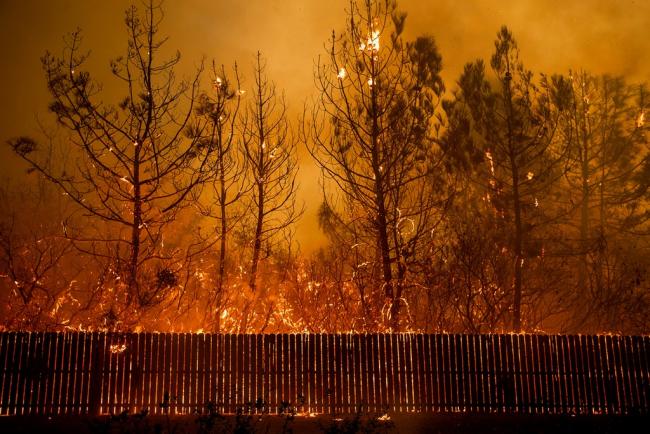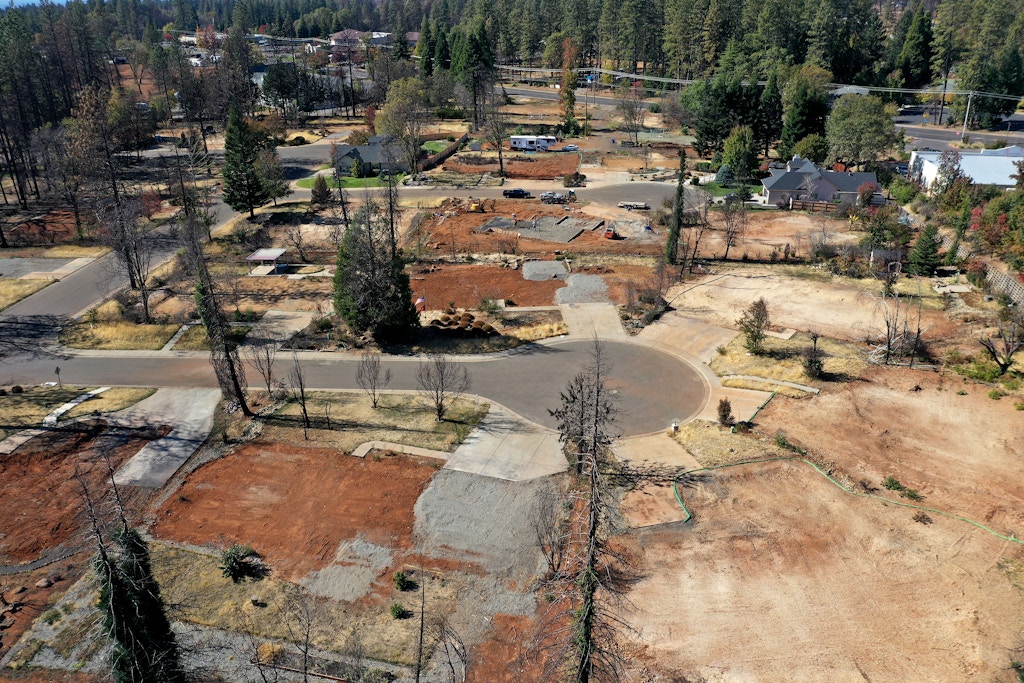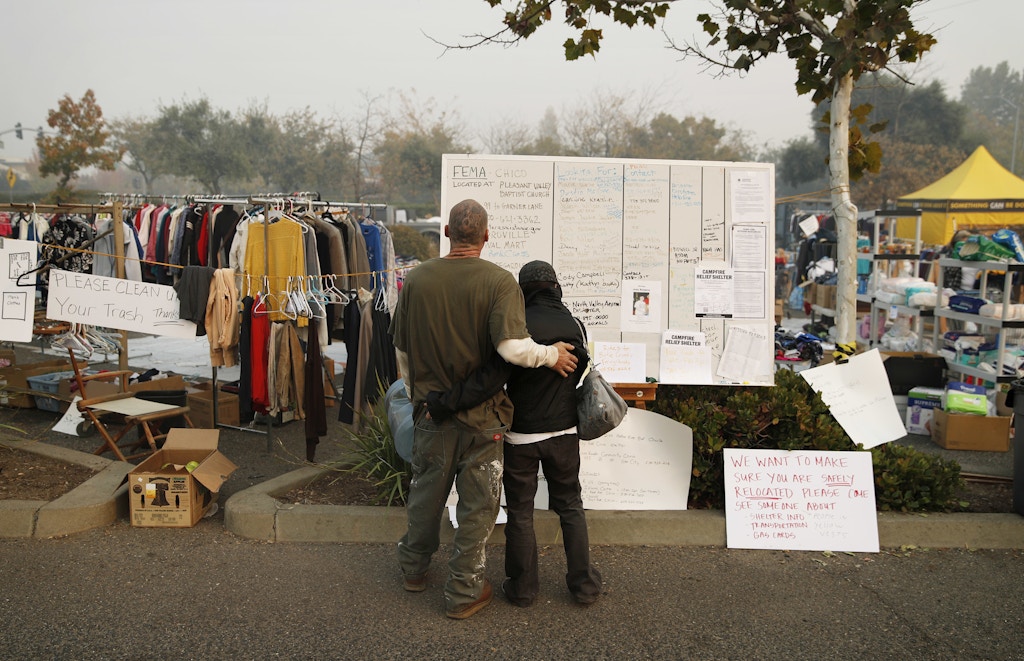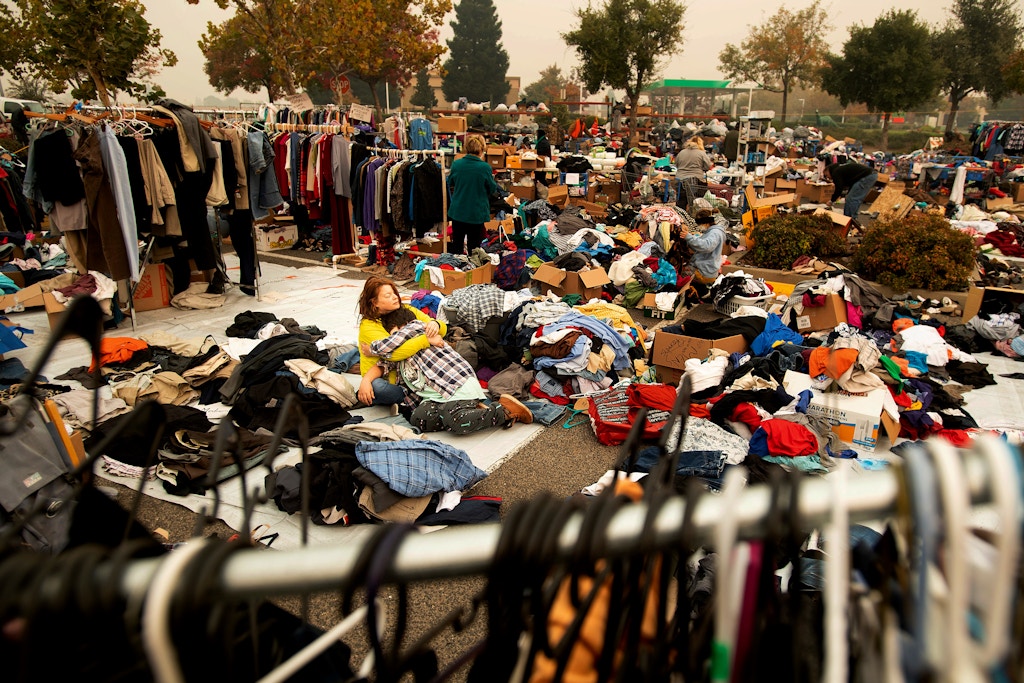Articles Menu

November 7 2019
WE WERE JUST TAKING PICTURES. Of the ash, stray bricks, and weeds. Of twisted metal and charred patio furniture. Of the pine trees still standing on the edge of the lots, their towering trunks now charcoal black. Of the lonely white brick fireplace in the middle of it all, the only surviving structure, metal pokers hanging expectantly by the grate.
“Get the hell off my property!”
The words came bellowing from a burly man who had just pulled up to the pile of ash that once was his home in Paradise, California. As he shouted a litany of complaints, it became clear that his rage wasn’t only reserved for us trespassers — and there have been plenty who have gone to Paradise to gaze at the eerie emptiness where a thriving community once stood, before it was decimated by California’s deadliest fire one year ago.
The target was myriad forces that had conspired to twist the knife, again and again, on his already wrenching property loss — from the insurance company that wouldn’t pay up, to the county that wouldn’t let him clean up, to the state that wanted his (now contaminated) well to be sealed up. His rage was also directed at the absence of decent temporary housing for fire victims like him, not to mention the electric utility that had started the blaze and was still evading responsibility.
When the complaints petered out, I approached the man to introduce myself and apologize for our intrusion. But as I got closer, I felt his volatility: I have been in many disaster-struck communities and know how quickly the gale-force of emotion these events churn up can direct itself at the closest available target. We wished him luck and left.
The encounter was a reminder of the kind of stress that is in the air in the parts of California recently scorched by fire, as well as in the communities that have welcomed thousands of newly homeless neighbors to towns now bursting at the seams. The intersecting hardships experienced by so many in the region also explain why, days before the one-year anniversary of the deadly Camp Fire that burned down Paradise and killed 86 people, local politicians in neighboring Chico unveiled a plan calling for the small city to adopt its own Green New Deal.
Like its national inspiration, the Chico Green New Deal framework marries rapid decarbonization targets with calls for more affordable housing; a safe and sustainable food system; investments in “clean, 21st century” public transit; green jobs creation, including projects earmarked for the poorest residents; and much more.
Chico shows that there is no way to cope with climate breakdown without a simultaneous shift to a very different kind of economy.
“Your city council has heard the call of its community that has resounded locally and across the nation,” said Chico Vice Mayor Alex Brown when the plan was announced. “We are choosing to walk the walk of this movement and to take the leadership being demanded of us.” In an interview, Brown told me that the Camp Fire’s impact on both Paradise and Chico was a glimpse of the future unless action is taken to both radically lower emissions and build “communities that are more resilient to these shifts.” Brown is well aware that a small city like hers isn’t going to make much of a dent in global emissions. But, she said, “We can demonstrate what a Green New Deal looks like at the local level.”
The Chico plan is one of many similar local initiatives that have sprung up in the year since the Sunrise Movement occupied the office of then-prospective House Speaker Nancy Pelosi, with young demonstrators demanding that the Democratic Party embrace a sweeping Green New Deal to meet the twin crises of climate disruption and deepening inequality. Since then, as the Green New Deal proposal has picked up momentum in the Democratic primaries, several states and big cities have unveiled their own frameworks, including Maine and Seattle, where city council recently passed a resolution that included the city’s most ambitious climate justice targets to date. It also pledged to create an oversight board to hold the city to its commitments, a body that will be made up of representatives from communities directly impacted by racial, economic, and environmental injustice, as well as climate experts and representatives from trade unions and green groups.
And yet the contribution now coming from humble Chico — a scrappy northern California college town with a population of approximately 100,000 — may be the most politically significant. Because the Chico Green New Deal is based directly on this region’s hard-won experience of living through the 2018 inferno; it was forged, quite literally, in fire.
Ever since the Green New Deal landed on the political map, liberals have attacked it for its supposedly impractical scope and ambition. Fighting poverty, racism, and homelessness are worthy goals, we have been told — but what do they have to do with lowering greenhouse gas emissions? Surely a carbon-centric approach — like a simple tax or cap-and-trade and some narrow regulations on polluters — would be more likely to succeed. And besides, connecting greenhouse-gas reductions with building a fairer society just confirms Republican beliefs that climate change is a vast left-wing plot: Better to focus exclusively on pollution and worry about the rest down the road. Conservative Chico city council members have gone on the offensive against the Green New Deal with precisely this kind of attack.

An aerial view of a destroyed neighborhood in Paradise, Calif., on Oct. 21, 2019, one year after the Camp Fire.
Photo: Justin Sullivan/Getty Images
Yet Chico’s lived experience over the past year is a devastating rebuke to this line of criticism. As the community that housed the vast majority of people displaced by the Camp Fire, Chico shows that there is no way to cope with climate breakdown without a simultaneous shift to a very different kind of economy, one that is willing to make major nonmarket investments in housing, transit, health (including mental health), water, electricity, and more.
Because what I found in Chico and what’s left of Paradise on my recent visit were people who had behaved with heroic solidarity. Tested by disaster, these communities had come together and looked after one another. At least they did at first. But saddled with basic infrastructure made brittle by decades of underinvestment and privatization, combined with powerful market incentives to profit from disaster, they soon discovered that the decks were stacked against those early efforts. That’s why so many in the community have concluded that the impacts of climate disruption simply cannot be handled without big structural changes on the order of a Green New Deal. Some of these investments can be done locally; others will need bold state and federal support.
Mark Stemen, a professor of geography and planning at Chico State, was my guide through Paradise and Chico and has been at the forefront of many of these debates. For him, the story of the wildfire and its aftermath makes the case for this holistic model of change.
“Some of the most beautiful nights were in the Walmart parking lot,” Stemen told me as we drove the Skyway out of Paradise and approached the big-box retailer on the outskirts of Chico. The black asphalt surrounding the store, he explained, acted as a fire break, repelling the flames that destroyed between 17,000 and 19,000 structures up the road. So, as cars and trucks fled that rain of fire, hundreds of them pulled into the Walmart parking lot, safe at last.
There they were met by North Valley Mutual Aid, the now legendary anarchist disaster response group that self-organized in the immediate aftermath of the fire. Thanks in large part to these grassroots activists, the evacuees who ended up at the Chico Walmart were greeted with clothing, pollution masks, hot meals, dog food, and much more. A whiteboard shared information about people who were still missing. Portable toilets appeared and showers a few days later. Walmart donated some supplies —and also made a killing selling tents, sleeping bags, and whatever else anyone needed.
Soon, the parking lot and the empty field next to it were transformed into a bustling, pets-welcome campground, a place for those made homeless by the fire to stay connected while finding their feet — and a place for Chico’s residents to show up with donations and offers of spare bedrooms.

Tera Hickerson, right, and Columbus Holt embrace as they look at a board with information for services at a makeshift encampment outside a Walmart store for people displaced by the Camp Fire in Chico, Calif., on Nov. 16, 2018.
Photo: John Locher/AP
It’s true that California’s fires have provided the world with some extraordinary examples of disaster capitalism and climate apartheid: ultrarich mansion owners protecting their homes with private firefighters and failing to inform their immigrant housekeepers and gardeners that their workplaces were under evacuation; Cal Fire’s reliance on hyper-exploited prison inmates to do some of the most dangerous firefighting in the state; migrant farmworkers in wine country forced to work in a haze of wildfire smoke.
But one year ago, Chico and Paradise seemed to provide a counterpoint to all this. Indeed, many saw those early days and weeks after the fire as a powerful embodiment of the solidarity and generosity that humans are capable of when faced with adversity. In Paradise, nurses, doctors, and elder care workers went to heroic lengths to save the lives of the people in their care. Chico’s residents, meanwhile, knew that what had happened to their neighbors in Paradise could have easily happened to them — and with the warm, dry weather of climate disruption, it could still happen to them at virtually any time.
And so they found their best selves: They shared what they had, opened their homes to strangers, asked people what they needed, and made it happen. The Chico State sports clubs and teams showed up at the various evacuation centers and played games with the kids. Underlying this outbreak of mutual aid was an unspoken agreement that people in need have an inherent right to food and water and housing. Any whiff of profiteering was met with rage.
“A tsunami of fire and terror rolled down the hill from Paradise,” Stemen recalled, his voice catching. “But that tsunami was buffeted by a blanket of love and comfort.”
Except here is the trouble: Love and comfort may have been the dominant first responses, but we do not currently live in a society that is governed by those values. On the contrary, ours is an economy built to profit off even the most desperate human needs, from water to health care to shelter and warmth after horrific disasters. A case in point: PG&E, California’s much loathed private energy utility, has been selling generators off its “marketplace” website to customers who have lost power thanks to … PG&E.
And so as the reality set in that Chico’s population had grown by some 20,000 people, sharp feelings of scarcity and cutthroat competition began to descend over this parched piece of northern California.

Denise Chester, an evacuee of the Camp Fire, hugs her son Antonio Batres as she volunteers to sort clothes at a makeshift shelter in Chico, Calif., on Nov. 14, 2018.
Photo: Noah Berger/AP
Well before the Camp Fire, Chico had a serious shortage of affordable housing (indeed, many people who worked in Chico had to live in Paradise because it was cheaper). So it was only natural that, when free food and supplies started being distributed outside Walmart, many members of Chico’s chronically homeless population showed up alongside those who had just lost their homes in the Camp Fire. That was fine by North Valley Mutual Aid, which rejects any notion that there is a hierarchy of deserving and undeserving homeless people. Moreover, many Paradise evacuees camping outside Walmart reported learning valuable skills from folks with years of experience sleeping rough (including how to keep belongings safe and how to line tents with cardboard to stay dry).
But others disagreed. They portrayed the pre-fire homeless as invaders, interlopers, freeloaders. Meanwhile, as Black Friday approached, with its promise of blockbuster sales, Walmart started agitating to clear the parking lot and the tents in the neighboring field. Facing backlash, it offered up funds for a permanent homeless shelter in town — but according to Stemen, that was rejected by the neighborhood for the same reason such shelters are so often rejected: concerns about safety and property values.
Making matters worse has been an epidemic of the kind of stress I encountered on the pile of ash that was once a home in Paradise. I heard several stories of people who had opened their homes to strangers, only to watch helplessly as untreated trauma made living in close quarters unbearable. As is so often the case after disasters, rates of domestic violence increased sharply. Though they have gone down in recent months, Brown told me that the severity of domestic attacks remains elevated. She also confirmed the widespread perception of a spike in traffic accidents, the product of an influx of new cars on the roads, which has fueled “strain and stress getting from one place to another.”
Sustaining that empathetic impulse beyond the initial emergency takes more than good will. It takes good policy, alongside serious public investments.
Several researchers I spoke with observed that post-traumatic stress disorder was rampant, including for Chico residents who were not in the fires but spent days breathing smoke that they knew included the remains of dozens of people. And though there have been many examples of artists working with residents on public memorials and grieving ceremonies, there is nothing close to the level of mental health support that would have helped people to keep from turning on each other as a result of these overlapping pressures.
Adding to the cauldron of stress was the fact that that serious profiteering had set in. Rents in Chico shot up, along with home prices. Improbably, Realtor.com named Chico the hottest housing market in the nation.
“All of sudden, there was a whole new class of refugees on people’s couches: the evicted,” Stemen told me. “But they weren’t evicted by fire, they were evicted by greed.”
All of this had an impact on that initial wave of human solidarity. After all, it’s harder to feel good about being generous with your home and belongings when you keep hearing stories about the guy down the street who made a killing flipping his house thanks to post-disaster price inflation. Or the people buying up property in smoldering Paradise at bargain-basement prices. Or the developer who was fast-tracking plans to build a gated community outside of Paradise without public input or review — while seemingly having his luxury project subsidized with taxpayer dollars earmarked for disaster response.
It is experiences like these that have taught many Chico residents that, in the real world, climate action cannot be pried apart from the need to transform an economic model that systematically puts private profits above the public good. They have seen firsthand that while most people very much want to help their fellow humans after disasters, sustaining that empathetic impulse beyond the initial emergency takes more than good will. It takes good policy, alongside serious public investments.
Which brings us back to the Chico Green New Deal and its plan for green jobs, public transit, local food, reduced car traffic, and more affordable housing. As Brown puts it, a major lesson from the Camp Fire is that “one of the things we can expect is displacement” — people being forced to move from one community to another. Which is part of why investing in affordable housing is central to Chico’s climate plan.
But that lesson goes well beyond Chico. With drought and sea-level rise already making large swaths of our warming planet uninhabitable, we have entered an era in which more and more people are going to have to live together on less and less land. If we don’t want that to plunge our societies deeper into xenophobic backlash, we will all have to rapidly embrace the kind of policies and supports that will help us live in these denser settlements without turning on one another.
One thing we most certainly cannot do is advance approaches to the climate crisis that make life more costly and most stressful — which, unfortunately, is precisely what too many climate policies have done. For 25 years, governments have been trying to find solutions to this crisis that did not clash with “free market” orthodoxies of deregulation, privatization, low taxes for the rich, and public austerity. And so, for instance, instead of telling polluters that they need to leave vast amounts of carbon in the ground (dismissed for years as “command-and-control” regulation), governments introduced emission trading schemes that created clever markets in pollution or imposed carbon taxes at the point of consumption. Instead of encouraging the use of clean public transit by making it better and more affordable (or even free) and tightly restricting the use of cars in cities, they argued over helpful but inadequate fuel efficiency standards and allowed transit fares to go up. Instead of nationalizing key sectors, like electricity and trains, that needed to embrace forms of change that do not necessarily return big profits to shareholders, they allowed for-profit companies to pay lip service to their plans to decarbonize while increasing rates.
There are a couple of problems with this approach. The first is that even when they do succeed in lowering emissions, they don’t do it on anything like the scale required to prevent climate breakdown. The other problem is that because these types of policies consistently offload the costs of transition onto already overburdened workers and consumers, while letting polluters off the hook, they almost invariably generate backlash.
We saw it in France with the Yellow Vest movement in response to a fuel tax. We are seeing it in Chile right now, which is being rocked by a popular revolt that began when the government of Sebastián Piñera increased the price of public transit, in part to defray the costs of purchasing a fleet of climate-friendly electric buses. We are seeing similar uprisings in Ecuador and Haiti, where the initial spark was cuts to fuel subsidies that made energy more expensive for the poor.
Increases in the prices of energy and transit are not the true causes of these popular mobilizations, not by any means. But in societies exhausted by policies of systemic immiseration imposed by corrupt elites, additional costs passed onto the public while inequality widens is most certainly proving a powerful catalyst.
The message, from Chico to Chile, is clear: If the responses to the climate crisis do not simultaneously begin to repair the wrenching injustices and inequalities that scar and strain our world, they have no hope of success. The bottom line is that people are already under too much stress and strain to take any more.
A Green New Deal-style approach — which fuses the battle against planet-warming pollution with the kinds of universalist health, housing, and transit policies that make daily life less stressful and more humane — is not, therefore, one of many possible climate solutions. Having exhausted every other option, it is the only kind of climate response that stands a chance of not going up in smoke.
Put bluntly, we will not do what is required to confront the climate emergency unless we are willing to confront the economic and social emergencies produced by decades of neoliberal policy. Or, as Stemen said, “For Chico, a Green New Deal is a way that we can have housing that both the people and planet can afford.”
Because it isn’t only our dry and overheated forests and grasslands that are tinderboxes, just waiting for a tiniest spark to go up in flames. All around the world, our human societies, scorched under the stresses of late capitalism, are political tinderboxes as well.
In the short window that remains, we need policies capable putting out all these flames.
[Top photo: Flames climb trees as the Camp Fire tears through Paradise, Calif., on Nov. 8, 2018.Photo: Noah Berger/AP]